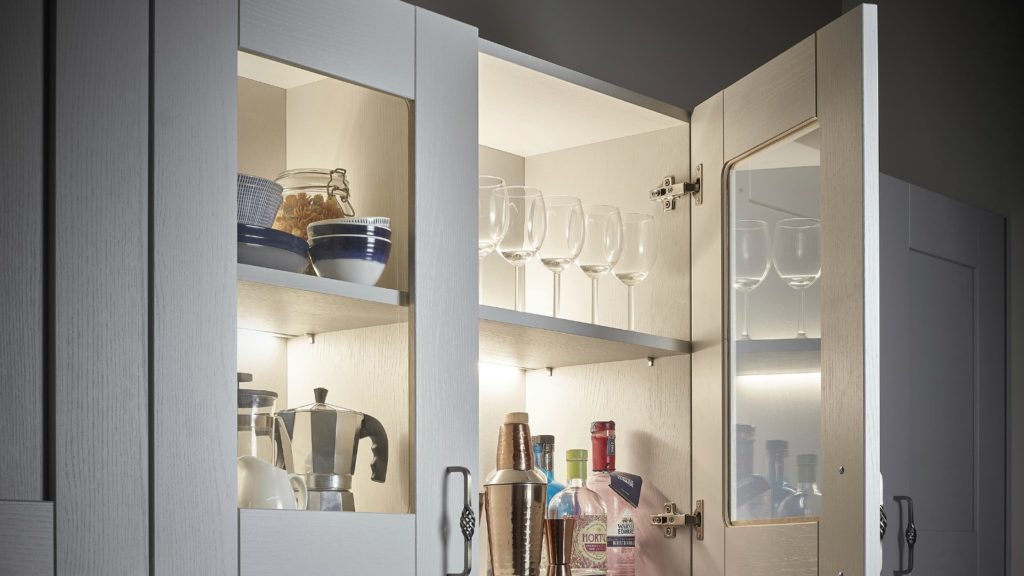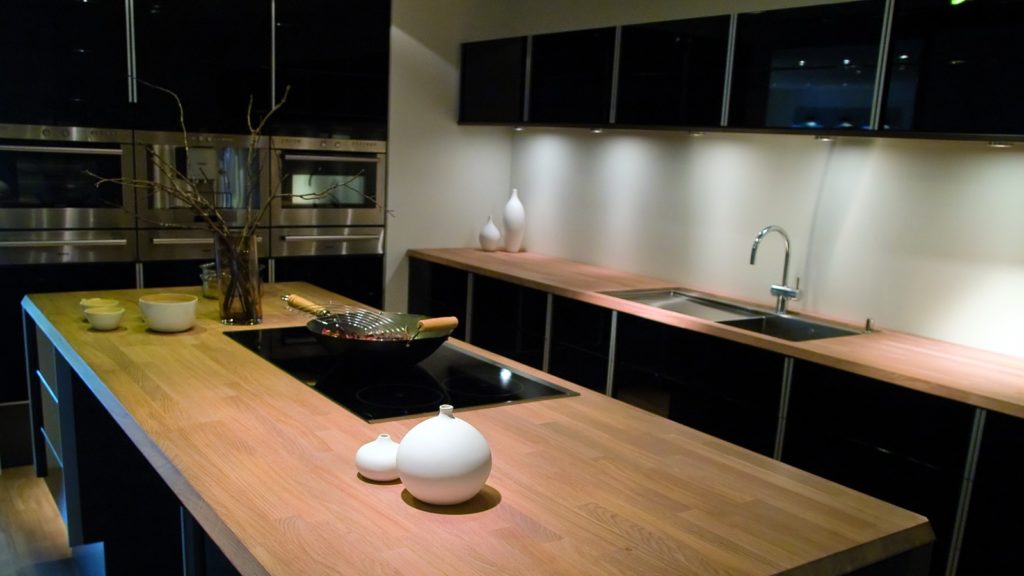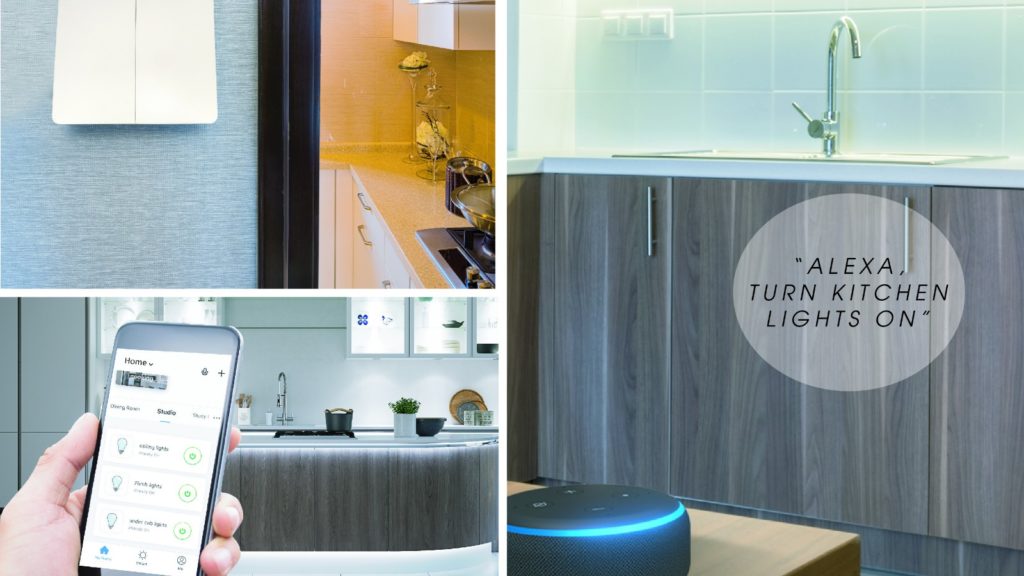
Conversations about kitchen lighting have long moved on from the need for task lighting and mood illumination.
Of course, these are still core to the basics of lighting design but they are now a given, and it is widely understood lighting has a major impact on the overall aesthetics.
Marketing manager for Sensio Lighting Joe Mitchell comments: “Well-conceived lighting can make a £5,000 kitchen look like a £10,000 kitchen, but an actual £10,000 kitchen can look inferior when designed without lighting.”
Sponsored Video
All of which means lighting has become much more sophisticated, with accomplished designers exploring far beyond the perennially popular under cabinet lamps.

Integral illumination
And lighting solutions have become more plentiful, offering greater choice for the kitchen designer.
Even the undercabinet light has been redefined with a choice of colour temperatures now available from one fitting.
However, product manager for lighting at Hafele UK Shaun Barker points to the variety of lighting on offer: “In recent years we’ve seen a real increase in the availability of creative lighting solutions, such as pendant lighting, strip lighting and colour-changing lighting,
“This has had a significant effect on kitchen design, opening up new possibilities in terms of functionality, aesthetics and layout.”
Lighting has also become more sophisticated and is now, in fact, an integral part of the kitchen architecture.
So much so, it even forms part of the structure, as marketing manager for Sycamore Lighting Mary Westmoreland explains: “LED strip is now being incorporated within worktops and is now gaining serious traction in how it is used with true handleless designs.”
And marketing manager for Sensio Lighting Joe Mitchell agrees integrated lighting is key for kitchen designers: “Kitchen design is changing as lighting manufacturers like Sensio develop product that is integrated into the furniture itself.”
He continues: “Internal strip lights, sensor-activated cabinet lights and internal shelving providing north/south luminosity have all started becoming factors in designing plans.”
And lighting has become more plentiful, offering greater choice for the kitchen designer. Even the undercabinet light has been redefined with a choice of colour temperatures now available from one fitting.
It has also become more sophisticated and is now, in fact, an integral part of the kitchen architecture. So much so, it even forms part of the structure, as marketing manager for Sycamore Lighting
Mary Westmoreland explains: “LED strip is now being incorporated within worktops and is now gaining serious traction in how it is used with true handleless designs.”
And marketing manager for Sensio Lighting Joe Mitchell agrees integrated lighting is key for kitchen designers: “Kitchen design is changing as lighting manufacturers like Sensio develop product that is integrated into the furniture itself.”
He continues: “Internal strip lights, sensor-activated cabinet lights and internal shelving providing north/south luminosity have all started becoming factors in designing plans.”
And interestingly these trends are not solely positioned at the top-end of the market but are available in the mainstream. Joe Mitchell of Sensio adds: “For lower to mid-end kitchens, it is all about clever lighting. These include integrated solutions such as internal cabinet lighting”, adding: “plinth lighting can provide a stunning effect when contrasted with glossy floor tiles.”
Bespoke lighting schemes
But experts also remind kitchen designers not to rely on a standardised approach to lighting specification.
Just as a kitchen scheme is tailor-made to suit a client’s needs and tastes, the lighting should be equally individual to the project. Joe Mitchell of Sensio comments:“Too many retailers fall into a comfort trap with three or four lighting products and re-us the same approach time and time again.
“Be an innovator, there are so many lighting products pushing the industry forward right now, don’t get left behind.”
And his views are echoed by Shaun Barker of Hafele who adds: “The sheer breadth of lighting options available, today, means that designers are able to move away from the one-size-fits-all approach and design lighting plans that are completely bespoke to each client. Budget and creativity are the only constraints.”
Gamechanging controls
In fact, there’s much more to lighting than lamp choice and fitting, with controls becoming smarter inline with the growth of the connected home, allowing for greater personalisation of lighting.
Think connectivity and even voice operated lighting systems. Shaun Barker of Hafele UK says: “Connected lighting systems, where lighting can be controlled through Wi-Fi with smart devices, have had a particular impact. Some intelligent lighting systems even allow users to create and recall pre-set light patterns at the touch of a button, easily adjusting the colour, brightness and type of beam that’s emitted.”
And Joe Mitchell of Sensio advises retailers to look out for smart technology, such as a smart driver that can be connected via Bluetooth to your Alexa which controls your kitchen lighting”.
He adds: “Also expect more unique design solutions to meet individual furniture specifications. These concepts could really revolutionise how lighting is perceived within the industry in future.”
Wi-Fi controls will be at the heart of a launch of products for Sycamore Lighting in 2019, as Mary Westmoreland explains: “We will be launching a brand new range of lighting controls in Q2 and these include wireless kinetic switching (no batteries) and plug and play app/voice controlled systems.
“Our system will allow any type of lighting to be dimmed and controlled via a mobile device or by using Alexa or Google Play. It can also be used in conjunction with other connected home appliances.”

Industry experts seem to be agree that smart lighting controls are in their infancy but will ultimately be a gamechanger for kitchen design.
And as manufacturers and retailers get behind the technology, smart controls will really gain traction.
Joe Mitchell is emphatic when he says: “I can see it exploding once word gets out about its ease of use and capability.
“The industry has never seen anything like this before.” And he stresses: “Those that adapt it immediately will have a competitive advantage that they could market and capitalise on.”
As the kitchen plays an ever greater role in the home, not only multifunctional in purpose but providing personalised architecture, so too should the kitchen lighting.
With a careful choice of lamps, fittings and now controls it’s more important than ever for designers to ensure illumination adapts swiftly and seamlessly to the needs and individual tastes of their clients.



